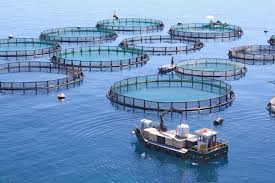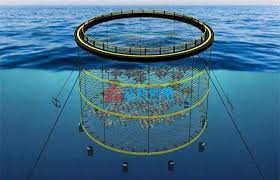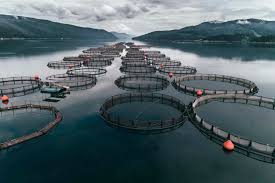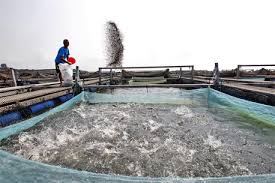Cage culture fisheries is an innovative aquaculture method that involves raising fish in submerged cages within natural or artificial water bodies, such as lakes, rivers, reservoirs, and oceans.
While this technique is primarily focused on fish farming, it parallels the selective breeding practices observed in livestock, such as various breeds of sheep (like Merino and Dorper) that are optimized for specific traits.
Cage culture in aquaculture has proven to be a highly efficient method of producing fish on a large scale, as it allows for controlled feeding, monitoring, and the management of fish stocks.
This method is especially popular in regions with limited land resources or where access to open water is readily available, providing an alternative to land-based fish farms.
The concept behind cage culture is simple yet effective. Fish are kept in large, floating cages that are secured within a body of water, creating a semi-controlled environment.
The cages, typically made from durable materials such as steel or high-density polyethylene, are designed to allow water to flow through freely. This continuous exchange of water supplies fish with fresh oxygen and disperses waste, helping to maintain a healthy environment and reduce the risks associated with water quality issues that often affect traditional fish ponds.
Cage culture offers several benefits over conventional fish farming techniques, such as improved productivity, higher stocking densities, and reduced land and infrastructure costs.
One of the significant advantages of cage culture is its flexibility in terms of location and scalability. Unlike traditional aquaculture systems that require large tracts of land, cage culture can be implemented in almost any water body with suitable conditions. This method makes it possible to grow fish even in urban areas, near coastal communities, or in reservoirs.
Additionally, cage culture allows for high-density stocking, meaning a large number of fish can be reared within a small area, which increases overall production and profit potential for fish farmers.
Cage culture fisheries also facilitate better management of fish health and nutrition. Because fish are contained within a controlled environment, farmers can easily monitor and regulate feeding schedules and diet quality.
High-quality feed can lead to faster growth rates, higher survival rates, and better meat quality. Moreover, monitoring fish health is easier as farmers can quickly identify and address any potential diseases or stress factors that may affect the stock.
These benefits make cage culture an ideal solution for producing various fish species, from tilapia and catfish to trout and salmon, which are all popular choices due to their adaptability and high market demand.
Despite its many advantages, cage culture also presents certain challenges. For instance, the high density of fish within cages can lead to stress and increased susceptibility to diseases if not managed properly.
Furthermore, environmental concerns such as the potential for pollution from uneaten feed and waste can impact surrounding ecosystems. Therefore, effective waste management practices and responsible feeding strategies are crucial for maintaining sustainability in cage culture fisheries.
History and Development of Cage Culture

Cage culture has ancient roots, with records indicating its use in Southeast Asia centuries ago. It gained significant traction in the 20th century as technology advanced, allowing for more efficient and sustainable fish farming.
The development of durable materials like polyethylene and galvanized steel enabled more secure, larger cages capable of withstanding various water conditions.
Key Milestones in Cage Culture:
1. Traditional Beginnings: Early forms of cage culture involved simple, woven bamboo or wooden enclosures placed in rivers or lakes, primarily used in Asia.
2. Modernization (1950s-1970s): The use of synthetic materials like nylon and polyethylene began, increasing cage durability and making the practice more widespread, particularly in Europe and North America.
3. Technological Advances (1980s-Present): Technological improvements in cage design, aeration systems, and feeding automation have boosted productivity, allowing for large-scale cage culture operations in both freshwater and marine environments.
Benefits of Cage Culture in Aquaculture
Cage culture offers multiple advantages, making it a popular method in aquaculture for both small-scale and commercial farmers.
1. High Stocking Density: Cage culture allows for higher stocking densities compared to traditional pond culture, increasing production capacity on the same water surface.
2. Flexibility and Mobility: Cages can be placed in various water bodies, such as rivers, lakes, and coastal areas, and can be easily relocated if needed.
3. Lower Initial Investment: Compared to constructing ponds or other aquaculture systems, cage culture requires less capital investment, as it utilizes existing water bodies.
4. Reduced Environmental Impact: By concentrating feed and waste in a smaller area, cage culture minimizes impact on surrounding ecosystems and reduces land use.
5. Easy Monitoring and Maintenance: Cages allow for easier monitoring of fish health, feeding, and growth, making management more straightforward and efficient.
Types of Fish Suitable for Cage Culture
Not all fish are suited for cage culture. Fish chosen for this system typically thrive in confined environments and demonstrate high growth rates and feed conversion efficiency.
1. Tilapia: Known for its rapid growth and adaptability, tilapia is one of the most commonly farmed fish in cage culture systems, particularly in tropical and subtropical regions.
2. Catfish: Catfish species such as channel catfish are well-suited to cage culture due to their resilience and fast growth rates, making them popular in North America and parts of Asia.
3. Salmon: In coastal areas, Atlantic salmon is commonly farmed in cage culture due to its high market value and consumer demand. Salmon cage culture is particularly prevalent in Norway, Canada, and Chile.
4. Sea Bass: Sea bass is popular for cage culture in coastal and marine environments, especially in Mediterranean countries, where it is highly valued for its taste and high market price.
5. Trout: Rainbow trout thrives in cooler waters and is suitable for cage culture in freshwater lakes and rivers, particularly in North America and Europe.
6. Snapper: This species is popular in Southeast Asia and Australia for cage culture, especially in marine environments, due to its resilience and demand in seafood markets.
Site Selection for Cage Culture Fisheries
1. Water Quality: Choose a site with high water quality to support fish health and growth. Ideal water should have good oxygen levels, minimal pollutants, and stable temperatures suitable for the fish species being cultivated.
2. Water Depth and Flow: Look for a location with adequate depth, ideally between 3-6 meters, to allow for optimal water movement and oxygenation. Moderate water flow helps remove waste, reduce disease risk, and maintain healthy fish stock.
3. Accessibility: Ensure the site is accessible for routine maintenance, feeding, and harvesting activities. Accessibility is important for transporting materials and managing the daily operations of the cage culture system.
4. Protection from Environmental Hazards: Choose a location that is sheltered from strong winds, waves, and extreme weather events. This will help protect the cages, reduce fish stress, and maintain structural integrity.
5. Permits and Regulations: Before setting up, check for any local or national regulations governing aquaculture in natural water bodies. Compliance with these regulations is essential to avoid legal issues and ensure sustainable operations.
Read Also: 12 Medicinal Health Benefits of Emilia Sonchifolia (lilac tasselflower)
Cage Design and Materials

1. Cage Frame: The cage frame should be constructed using durable materials like PVC, galvanized steel, or HDPE (high-density polyethylene). These materials are resistant to rust and corrosion, ensuring the cage’s longevity.
2. Netting: The cage’s netting must be sturdy enough to withstand environmental forces and prevent fish escape. Nylon or polyethylene mesh is commonly used due to its durability and ability to allow good water flow while keeping predators out.
3. Floats and Anchors: Floats should be made from durable materials like plastic or foam to support the cage’s weight. Anchors are essential for keeping the cage in place and should be securely fastened to prevent drifting or shifting.
4. Shape and Size: Cages can be square, rectangular, or circular, with sizes depending on the type of fish and the number of fish to be raised. Circular cages generally allow for better water flow and are less susceptible to wear and tear compared to square or rectangular designs.
5. Maintenance: Regular maintenance is key to prolonging the life of the cages. Inspect the frame, netting, and anchoring system routinely for signs of wear or damage, and repair as needed.
Fish Stocking and Management
1. Species Selection: Choose fish species that are well-suited to cage culture, such as tilapia, catfish, or salmon. Consider local environmental conditions and market demand when selecting species.
2. Stocking Density: Maintain an optimal stocking density to ensure fish have enough space for growth and minimize stress. High stocking densities can lead to competition for resources, lower water quality, and increased risk of disease.
3. Health Monitoring: Monitor fish regularly for signs of stress or disease. Fish health can be affected by poor water quality, overcrowding, and inadequate nutrition, so it’s essential to observe fish behavior and inspect them frequently.
4. Predator Control: Use netting or predator deterrent devices to protect fish from predators such as birds, turtles, and larger fish. Ensuring the cages are predator-proof will help maintain fish stock and reduce losses.
5. Record Keeping: Keep accurate records of fish stocking, growth rates, health issues, and environmental conditions. This information helps track performance, make informed management decisions, and improve future production.
Feeding Strategies in Cage Culture
1. Feed Selection: Use high-quality commercial fish feed that meets the nutritional requirements of the fish species being raised. The feed should be appropriate for the species’ growth stage and desired production goals.
2. Feeding Schedule: Implement a consistent feeding schedule, ideally two to three times a day, depending on the species. Regular feeding times help maximize feed utilization and support optimal growth rates.
3. Feeding Techniques: Consider automatic feeders or hand-feeding to ensure feed is distributed evenly throughout the cage. Avoid overfeeding, as excess feed can lead to poor water quality and increased production costs.
4. Monitoring Feed Consumption: Observe fish feeding behavior to determine the appropriate amount of feed and reduce waste. Adjust feeding rates based on fish appetite, growth stage, and seasonal temperature changes.
5. Water Quality Monitoring: Maintain good water quality by monitoring parameters like dissolved oxygen, temperature, and pH levels. Poor water quality can reduce feed conversion efficiency, negatively affecting fish health and growth.
Water Quality Management in Cage Culture
Proper water quality is critical for fish health and growth in cage culture systems. Here are some essential water quality management practices:
1. Regular Monitoring: Regularly test for temperature, dissolved oxygen, pH, and ammonia levels. This can be done with portable water testing kits or automated monitoring systems, which help detect any fluctuations and allow for prompt corrective action.
2. Oxygenation: Dissolved oxygen levels should ideally be above 5 mg/L for most fish species. Ensure that water flow is adequate for natural oxygenation, and consider using aerators during low-oxygen periods, such as hot weather or overcrowding.
3. Waste Management: Uneaten feed and fish waste can degrade water quality. Implement feeding schedules to avoid overfeeding and install nets or screens to trap excess food particles. Natural water flow can help flush out waste, but if the site has poor water circulation, more frequent cleaning may be necessary.
4. Temperature Control: Monitor water temperature closely, as fish have optimal temperature ranges for growth. Choose cage sites with stable temperature profiles and consider species that can thrive in the specific temperature conditions of your area.
5. pH Balance: The ideal pH range for cage culture is between 6.5 and 8.5. If the pH is too low or too high, fish can experience stress, leading to poor growth and increased susceptibility to disease. Natural water bodies usually maintain stable pH, but it’s important to keep an eye on it.
Disease Prevention and Control
Maintaining fish health is essential to the success of cage culture systems. Here are some practices for disease prevention and control:
1. Quarantine New Stock: Before introducing new fish into cages, quarantine them to prevent introducing pathogens. This helps avoid the spread of diseases within the main stock.
2. Regular Health Checks: Observe fish behavior and appearance regularly. Signs of disease can include discoloration, changes in swimming behavior, and reduced appetite. Early detection is crucial for effective treatment.
3. Vaccination: Where possible, vaccinate fish against common diseases specific to the species being raised. This can significantly reduce the risk of disease outbreaks and improve survival rates.
4. Biosecurity Measures: Limit access to the cage culture area to essential personnel only, and ensure that equipment is cleaned and disinfected regularly. This minimizes the introduction of pathogens from external sources.
5. Medication and Treatment: In case of an outbreak, isolate affected cages and treat with appropriate medications as per veterinary guidance. Always follow proper dosage and withdrawal periods for any medication to ensure fish health and safety.
Read Also: Factors Affecting Mineralization and Nitrification Dendrobium Nobile Medicinal Plant
Economic Viability of Cage Culture

Cage culture can be economically viable due to its lower infrastructure costs compared to traditional land-based systems. Here are some factors that affect its economic viability:
1. Initial Investment: Although cage culture requires a lower initial investment compared to ponds or tanks, costs can vary based on cage material, site selection, and equipment for feeding and monitoring.
2. Operating Costs: These include feed, labor, maintenance, and health management. Automated feeding and monitoring systems can reduce labor costs but increase initial setup expenses.
3. Feed Efficiency: Feeding costs often account for the largest part of operating expenses. Ensuring high feed conversion ratios (FCR) is key to maximizing profitability, so quality feed and proper feeding practices are important.
4. Market Demand and Pricing: Cage culture fish, particularly species like tilapia, catfish, and salmon, are often in high demand. Researching local and export markets can help farmers choose profitable species and maintain competitive pricing.
5. Environmental Impact and Compliance: Adhering to environmental regulations may involve additional costs, such as waste management or water quality monitoring systems. Compliance is essential to ensure long-term viability and avoid fines.
Challenges and Future Prospects of Cage Culture Fisheries
While cage culture offers numerous benefits, it also faces several challenges. Let’s explore both the challenges and future prospects of this aquaculture method:
Challenges
1. Environmental Impact: Waste buildup can harm local ecosystems if not properly managed, affecting water quality and biodiversity. Responsible waste management practices are necessary to mitigate these impacts.
2. Disease and Parasite Management: Cages in natural waters are exposed to diseases and parasites that may be present in the ecosystem. These pathogens can spread easily among densely stocked fish.
3. Regulatory Issues: Some regions have strict regulations on using natural water bodies for aquaculture. Farmers may face licensing challenges, zoning restrictions, and environmental compliance costs.
4. Climate Change: Rising temperatures, storms, and unpredictable weather patterns can affect water quality, fish health, and cage integrity, posing challenges for long-term cage culture operations.
5. Predation: Fish in cages can be vulnerable to predators, such as birds, larger fish, or even mammals. Protective netting can help but may not eliminate predation risks entirely.
Future Prospects
1. Technological Advancements: Innovations in automated feeding systems, remote monitoring, and waste management can improve efficiency and make cage culture more sustainable. Advances in technology also aid in disease monitoring and control.
2. Sustainable Practices: Integrating cage culture with other sustainable practices, such as polyculture (raising multiple species) and biofloc technology, can improve ecosystem health and resource efficiency.
3. Expansion into New Markets: With rising global demand for fish protein, cage culture can help meet market needs, especially in regions with limited land availability. Export opportunities may also grow, benefiting local economies.
4. Improved Fish Breeding: Selective breeding and genetic advancements can lead to fish stocks that are more resistant to diseases, grow faster, and are better suited to cage culture environments.
5. Environmental Regulation and Support: As governments and environmental organizations recognize the importance of sustainable aquaculture, policies and support for eco-friendly cage culture systems are likely to increase.
Cage culture is a versatile and efficient aquaculture method with a rich history and a range of benefits, making it a preferred choice for fish farmers globally.
By choosing the right fish species and utilizing modern technology, farmers can maximize production and contribute to sustainable aquaculture practices.
Cage culture’s adaptability allows it to be used in various aquatic environments, offering both economic and environmental advantages in the growing field of aquaculture.
Do you have any questions, suggestions, or contributions? If so, please feel free to use the comment box below to share your thoughts. We also encourage you to kindly share this information with others who might benefit from it. Since we can’t reach everyone at once, we truly appreciate your help in spreading the word. Thank you so much for your support and for sharing!
Read Also: 8 Amazing Health Benefits to Eating Hot Peppers






